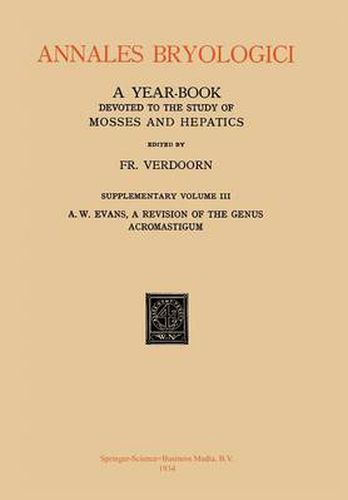Readings Newsletter
Become a Readings Member to make your shopping experience even easier.
Sign in or sign up for free!
You’re not far away from qualifying for FREE standard shipping within Australia
You’ve qualified for FREE standard shipping within Australia
The cart is loading…






This title is printed to order. This book may have been self-published. If so, we cannot guarantee the quality of the content. In the main most books will have gone through the editing process however some may not. We therefore suggest that you be aware of this before ordering this book. If in doubt check either the author or publisher’s details as we are unable to accept any returns unless they are faulty. Please contact us if you have any questions.
The writer’s genusAcromastigum( I 0) illustrates terminal branching from both lateral and ventral segments and is the only genus of the Hepaticae with which the latter type of branching has been associated. The branches arising in this exceptional manner are flagelliform in character, and each shows at the base a narrow and incomplete underleaf. This represents the part of the segment that was not involved in the formation of the branch. In the writer’s discussion of branching in the leafy Hepaticae (II, p. 23), terminal branching from ventral segments is definitely distinguished as the Acromastigztm type, and its distinctive features are pointed out. In the genus Bazzania, or M astigobryum as it is often called, the ventral flagelliform branches are intercalary in origin and arise in the axils of underleaves. Except for this important difference the genera Acromastigum and Bazzania have much in common, and the only species of Acromastigum which has so far been recognized was origi- nally referred, with some doubt, to the genus M astigobryum. This species, which is now known as A. integrifolium (Aust.) Evans, is apparently confined to Hawaii.
$9.00 standard shipping within Australia
FREE standard shipping within Australia for orders over $100.00
Express & International shipping calculated at checkout
This title is printed to order. This book may have been self-published. If so, we cannot guarantee the quality of the content. In the main most books will have gone through the editing process however some may not. We therefore suggest that you be aware of this before ordering this book. If in doubt check either the author or publisher’s details as we are unable to accept any returns unless they are faulty. Please contact us if you have any questions.
The writer’s genusAcromastigum( I 0) illustrates terminal branching from both lateral and ventral segments and is the only genus of the Hepaticae with which the latter type of branching has been associated. The branches arising in this exceptional manner are flagelliform in character, and each shows at the base a narrow and incomplete underleaf. This represents the part of the segment that was not involved in the formation of the branch. In the writer’s discussion of branching in the leafy Hepaticae (II, p. 23), terminal branching from ventral segments is definitely distinguished as the Acromastigztm type, and its distinctive features are pointed out. In the genus Bazzania, or M astigobryum as it is often called, the ventral flagelliform branches are intercalary in origin and arise in the axils of underleaves. Except for this important difference the genera Acromastigum and Bazzania have much in common, and the only species of Acromastigum which has so far been recognized was origi- nally referred, with some doubt, to the genus M astigobryum. This species, which is now known as A. integrifolium (Aust.) Evans, is apparently confined to Hawaii.